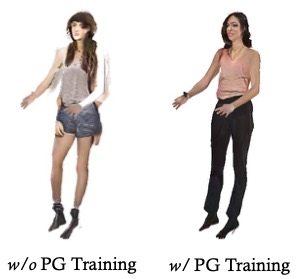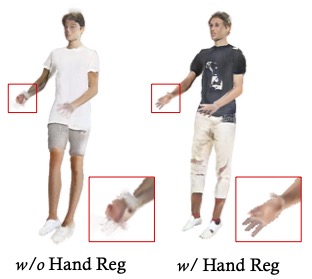ABSTRACT
Access to high-quality and diverse 3D articulated digital human assets is crucial in various applications, ranging from virtual reality to social platforms. Generative approaches, such as 3D generative adversarial networks (GANs), are rapidly replacing laborious manual content creation tools. However, existing 3D GAN frameworks typically rely on scene representations that leverage either template meshes, which are fast but offer limited quality, or volumes, which offer high capacity but are slow to render, thereby limiting the 3D fidelity in GAN settings. In this work, we introduce layered surface volumes (LSVs) as a new 3D object representation for articulated digital humans. LSVs represent a human body using multiple textured mesh layers around a conventional template. These layers are rendered using alpha compositing with fast differentiable rasterization, and they can be interpreted as a volumetric representation that allocates its capacity to a manifold of finite thickness around the template. Unlike conventional single-layer templates that struggle with representing fine off-surface details like hair or accessories, our surface volumes naturally capture such details. LSVs can be articulated, and they exhibit exceptional efficiency in GAN settings, where a 2D generator learns to synthesize the RGBA textures for the individual layers. Trained on unstructured, single-view 2D image datasets, our LSV-GAN generates high-quality and view-consistent 3D articulated digital humans without the need for view-inconsistent 2D upsampling networks.
LSV-GAN Overview
|
LSV-GAN pipeline. A latent code z is fed into a 2D StyleGAN2 generator network, which outputs N RGBA textures. These are applied to the individual mesh layers. All textured layers together are deformed into the target pose distribution and rendered using fast, differentiable rasterization before being fed into a camera- and body-pose-conditioned StyleGAN2 discriminator. An additional face discriminator is used but not shown.
|



